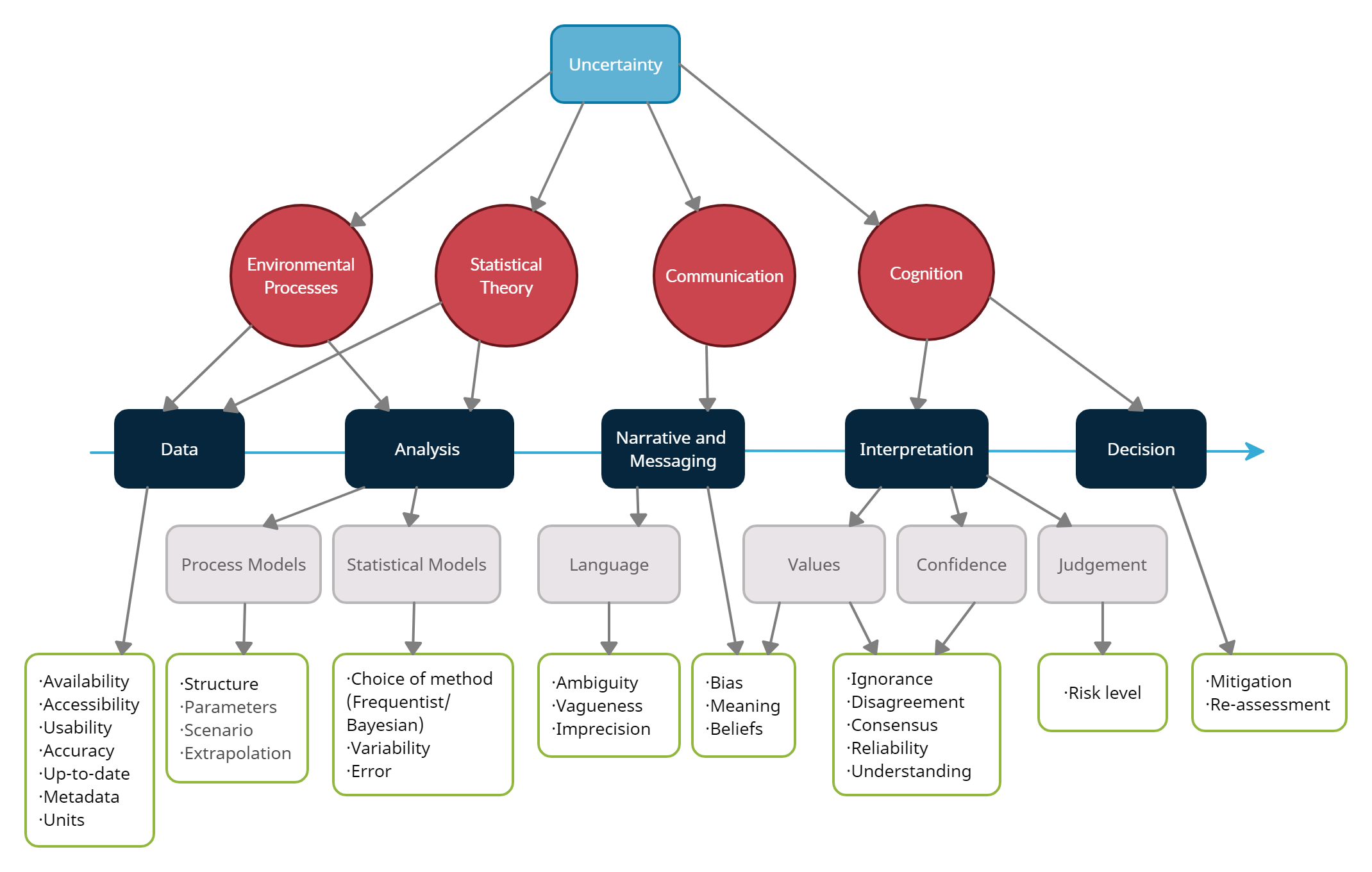Data to Decision: uncertainties in environmental data science
Posted on

Presented at the Conference on Environmental Data Science, 5-7 July 2022, this poster provides a new typology of uncertainty for environmental data science. Based on multidisciplinary theories (c.f. Walker et al, 2003; Skinner et al, 2014; Bevan 2022) and data collected from interviews and focus groups, this poster shows the uncertainties experienced by experts from different environmental sciences, computer science and statistics, as well as science communicators and decision makers.
Applying data science techniques to environmental issues is a relatively new research area and is increasingly being used for decision making. This typology provides an overarching view of all the uncertainties experienced by the different stakeholders along the data to decision pathway, from the data collector, data analyser, statistical and process modellers, through to the decision maker themselves. Understanding the many sources of uncertainty along this pathway aids provision of robust scientific evidence to underpin decision-making, with this evidence enabling the decision maker to appreciate the level of risk they are taking. Additionally, having these sources set out in a framework encourages full transparency of the uncertainties at each part of the pipeline.
As mentioned in my previous blogs, uncertainties are an inherent feature of scientific research; these can be ‘aleatory’ due to the random nature of the world; or ‘epistemic’ due to limited knowledge or ignorance, and thus could be reduced with further research. Alongside these, linguistic ambiguities (e.g. Regan et al, 2002) can occur due to the collaboration of researchers with different disciplinary backgrounds. Scientific uncertainties impact on actions taken by stakeholders. Additionally, researchers need to consider that interpretation of – and response to – uncertainty, differs between individuals.

This typology shows how these fit into four main categories of uncertainty for environmental data science:
Environmental processes – considers the uncertainties experienced when trying to understand what is happening in the environment. The output from models can be affected by the input parameters and uncertainties in the model structure.
Statistical Theory – provides quantitative assessment of uncertainty and therefore the probability or likelihood of an event/s or environmental change/s occurring. Statistical uncertainty is seen as controllable, with other uncertainties, that cannot be managed with statistics, labelled ‘deep’ or ‘severe’ (c.f. Walker et al, 2012).
These two categories cover the uncertainties that occur within data and analysis methods, many of these listed on the diagram are epistemic uncertainties, however, aleatoric uncertainties can also be experienced, and are managed using statistical techniques.
Communication – this covers language uncertainties, such as ambiguities, that can occur when different disciplines are combined; along with uncertainties that can be created by how the research is presented and the message it portrays.
Cognitive – this covers the researchers' confidence in their work, as well as the understanding and values of the decision makers. Under this section, judgment about the level of uncertainty would be considered, and the level of risk from making, or not making, a decision.
These two categories allow incorporation of the qualitative uncertainties that can affect a decision. It includes the values or beliefs of all stakeholders, as well as a personal confidence in the methods and/or data or in the work of others, which therefore affects one's level of confidence in the results.
Below these four main categories is the data to decision pathway, showing the areas of research where uncertainties occur and listing specific problems that were described by the interviewees and focus groups. Understanding where these different uncertainties arise and how they may compound along the pathway allows for incorporation of different methods to deal with, and reduce, some of the uncertainty, to provide better evidence for decisions. Tackling environmental problems requires decisions based on cross-disciplinary, open and transparent research, with recognition of the sources of uncertainties. This typology offers a framework for reasoning about uncertainty end to end – and provides a basis for building trust in environmental decision making.
Related Blogs
Disclaimer
The opinions expressed by our bloggers and those providing comments are personal, and may not necessarily reflect the opinions of Lancaster University. Responsibility for the accuracy of any of the information contained within blog posts belongs to the blogger.
Back to blog listing



